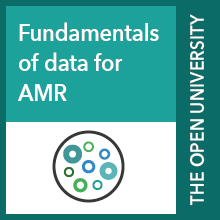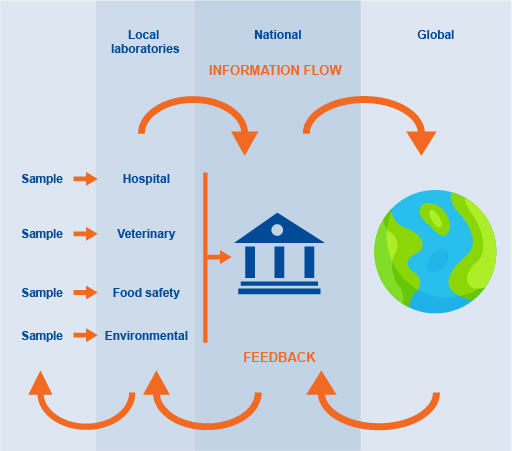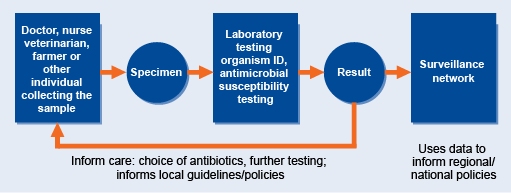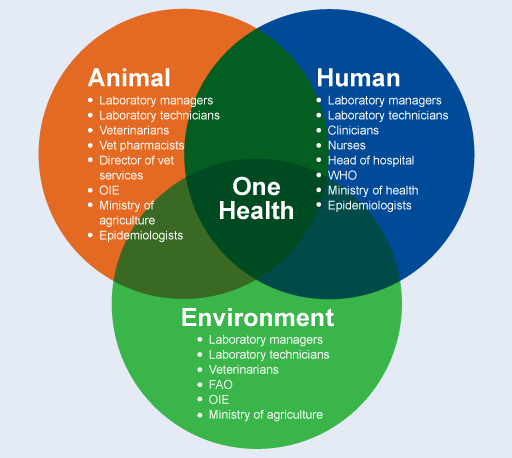Use 'Print preview' to check the number of pages and printer settings.
Print functionality varies between browsers.
Printable page generated Tuesday, 7 May 2024, 5:55 PM
AMR surveillance and you
Introduction
Antimicrobial resistance (AMR) is a major global concern because drug-resistant infections can kill, spread to others, and impose huge costs on individuals and society. In order to tackle this problem we first need to understand it; we can do this by collecting and sharing high-quality data that is relevant to AMR through systematic surveillance.
Surveillance data relating to AMR means that trends in resistance and antimicrobial use can be monitored and used to make better decisions to help tackle the AMR crisis. If you are involved in any activities related to AMR, you are likely to be contributing to AMR surveillance even if this role is not specifically part of your job description. Even if it’s not in your job title, you are an ‘AMR surveillance professional’.
Approaches to AMR surveillance will be covered in the modules An introduction to surveillance, Introducing AMR surveillance systems, An overview of national AMR surveillance and AMR surveillance in animals. As an AMR surveillance professional, you have a key role to play in this surveillance process, whether it is in collecting, analysing or interpreting data, or in using the data to develop new policies and practices.
About the Fleming Fund
The Fleming Fund is a UK aid programme to help low- and middle-income countries (LMICs) improve surveillance for bacterial AMR, so that data relevant to bacterial AMR is available to national and local decision-makers. It funds a range of initiatives in LMICs that aim to increase the quantity and quality of data to:
- better understand the scale and drivers of AMR
- inform policies and practices
- optimise the use of antimicrobial medicines.
It should be noted that although generally the term ‘antimicrobial resistance’ (or ‘AMR’) refers to resistance in all types of micro-organism, throughout this course it will predominantly be used to mean resistance in bacteria.
The aim of Tackling antimicrobial resistance is to help you to identify, develop and apply skills and knowledge relevant to your role in order to change and improve your working practice and the practice of people that you work with. The course’s main focus is AMR surveillance and the course materials are suitable for individuals who have a role in AMR surveillance programmes. However, even if you do not currently have a defined role in an AMR surveillance programme, you may (as noted above) be part of a surveillance system; for example, if you work in a laboratory that reports its results to a national system. And of course, everyone involved in healthcare has a role to play in reducing AMR, so you may find some of the materials in this course relevant to your work.
AMR surveillance and you is the first module in your study pathway. It is an opportunity for you to identify the skills and areas of knowledge that you need to develop for your role and to reflect on how your learning in the other modules can change your working practice in relation to AMR.
After completing this module, you will be able to:
- describe how antimicrobial resistance relates to your work
- understand what AMR knowledge and skills are required for your role
- identify areas where your knowledge and skills require development and plan a strategy to address these skills gaps
- know your responsibilities as a learner and the role that learning plays in your professional practice relating to AMR
- reflect on how your learning has changed your working practice relating to AMR.
1 About this course
Tackling antimicrobial resistance comprises 25 online modules. This module, AMR surveillance and you, is the first.
These online modules are delivered on the Fleming Fund’s OpenLearn Create site and include text, videos, diagrams, reflective activities, self-assessment questions and quizzes. Each module should take up to 6 hours to complete, but you can work through them at your own pace.
You do not need to study every module to complete the course. The modules that you chose to study, and the order that you chose to study them in, will depend on your role, the activities that you undertake and your personal learning goals. Activities 8 and 9 of this module will help you to identify your learning goals and select a recommended study pathway.
In each module there are numerous opportunities to check your learning, including interactive quizzes and activities to reflect on your learning. You will also have opportunities to reflect on how your learning on this course relates to your work.
At the end of each of the other modules in this course you will be awarded a digital badge. Digital badges are like a certificate: they demonstrate that you have gained a skill (Figure 1), or are evidence of your work and achievement on the module. You can download them and share them on your social media profiles on Facebook, Twitter or LinkedIn.

To be eligible for the digital badge you must read each page of a module and score 50% or more in the end-of-module quiz. For each quiz, you can have three attempts at the questions. If you get the answer right first time, you will get more marks than for a correct answer at the second or third attempt – so please be aware that it is possible to answer all the questions correctly but not achieve the 50% score to be eligible for a badge. If one of your answers is incorrect, you will receive helpful feedback and suggestions about how to work out the correct answer. When you have successfully achieved the completion criteria, you will receive an email notification that your badge has been awarded. Please note it can take up to 24 hours for a badge to be issued.
If you’re not successful in achieving 50% in the end-of-module quiz, after 24 hours you can try again, and come back as many times as you like.
At the end of this course you will be awarded a statement of participation. To be eligible, you must complete each module in a particular recommended study pathway. You can find out more about these pathways in Activity 9.
2 Introducing AMR surveillance
AMR surveillance is the ongoing collection, analysis, interpretation and dissemination of data related to AMR.
Globally, AMR surveillance provides early warnings about the spread of new resistant strains of bacteria, revealing trends and outbreaks of infection. AMR surveillance is critical to tackling AMR, since the data it yields can help to inform the best treatment and care (the right drug at the right dosage for the right amount of time) for humans or animals at a local level, even where it is not possible to test individually. At regional and national levels, surveillance data informs intervention priorities and helps to identify gaps in service delivery. At a national level, the data guides planning and resource allocation, and informs policies and responses to patterns and trends.
For countries supported by the Fleming Fund, most AMR surveillance is carried out using a sentinel site approach. In this approach, rather than collecting data from every healthcare facility or laboratory in the country, a selection of sites are used. Ideally, these sites are chosen because they can represent the population of the country as a whole. Data is gathered from a number of hospital sites and laboratories, and is collated for use as regional or national surveillance data (Figure 2).
At the local level, a clinician, nurse, veterinarian or other AMR surveillance professional takes a sample and sends it to the laboratory to be tested. Laboratories routinely test samples to provide clinicians and veterinarians with information that is used to diagnose and treat infections (Figure 3), such as whether a bacterium is growing, what type of bacterium it is, and what drugs can be used to treat the infection.
Local surveillance practice comprises the following broad task areas, all of which are critical for good quality data:
- collecting/receiving specimens, and logging specimen and relevant clinical information
- performing tests
- monitoring and documenting data
- interpreting data
- reporting and communicating the test results to the person submitting the test
- reporting and communicating the results/data beyond the laboratory – locally, nationally and globally.
These tasks are undertaken by professionals working together across different roles.
In the next section you will think more about how your role might relate to AMR surveillance.
3 Who is ‘the AMR surveillance professional’?
The responsibility for AMR surveillance is distributed across various professional roles – for example:
- clinicians, nurses and veterinarians collect samples and document the clinical information
- laboratory staff perform tests
- data scientists and epidemiologists analyse, interpret and report data
- senior managers and policy-makers use the data to develop policy and practice
- clinicians, veterinarians and pharmacists use the data to treat patients.
However, even if you do not have a specific, identifiable role in a surveillance programme, everyone involved in animal and human healthcare has a role to play in reducing AMR.
Activity 1: You as an AMR surveillance professional
Part 1
First you should fill in this questionnaire about your role as an AMR surveillance professional.
3.1 Communication between AMR surveillance professionals
Since the success of a surveillance system relies on many people working together across different roles, communication between these groups is crucial.
As an example, think about a group of musicians performing a piece of music. Each instrument has its own part that, when played alone, may sound like a series of notes without any melody. However, each member of the group contributes different parts of the piece, so that when they are all playing together their contributions add up to something better than their individual parts and the melody can be heard.
You can learn more about how your role relates to the roles of others in the AMR surveillance process in the modules Introducing AMR surveillance and Communicating AMR data to stakeholders.
Effective cross-team working within local teams is critical for the high-quality data needed for AMR surveillance. Think back to the analogy of the musicians: imagine that one member of the group has been given the wrong piece of music to play, or the performers all start playing at different times. How would the group sound? It is unlikely that their performance would sound very good. Likewise, every person in the AMR surveillance process contributes to the effectiveness of the system.
Activity 2: Your role in the surveillance process
Activity 3: Communication
You will learn more about communicating with AMR surveillance professionals beyond your workplace in the Communicating AMR data to stakeholders module. But for now, take a moment to note down anyone outside of your current workplace that is involved in your AMR work.
As you study Tackling antimicrobial resistance, you will see that AMR surveillance requires a One Health approach: the collaboration of multiple disciplines working locally, nationally and globally to achieve the optimal health of people, animals and the environment (Figure 5). You will learn more about this One Health approach in the module Introducing a One Health approach to AMR. Consequently, AMR surveillance that takes a One Health approach does not just require communication between those working in different roles in the human healthcare sector but also across different sectors.
4 The importance of learning as an AMR surveillance professional
For some people, being professional means being smartly dressed; for others, it means having advanced qualifications, being in a position of authority or supervising others. But being a professional is more than this: it is also about developing skills and competence in your chosen field.
Activity 4: What does being a professional mean to you?
Take a few moments to think about what being a ‘professional’ means to you.
Discussion
You may agree that being professional means being smartly dressed, supervising other or having advanced qualifications; but you may have thought of other things that relate to your role or your experience of working with other people. Being professional means different things to different people.
Surveillance work must be expanded and updated as new AMR surveillance practices and techniques are developed. This means that AMR surveillance professionals need to continually expand their practice and make sure they have up-to-date knowledge about surveillance techniques and data interpretation. As an AMR surveillance professional, you should be committed to learning and developing new skills and knowledge through continuing professional learning (which is sometimes known as continuing professional development, or CPD).
You probably have already had experience of many different opportunities to learn in relation to your role as an AMR surveillance professional. Some of them may have been formal: lectures or classes at your school, college or university, for example. Others, like learning from one of your colleagues, may have been informal.
Think about the learning that you have already undertaken as part of your role. What examples of formal and informal learning have you experienced?
Examples of formal learning could include classroom learning, laboratory training courses, seminars or web-based e-learning like these online modules. Examples of informal learning could include mentoring, reading journal articles, networking and attending conferences. Don’t worry if you didn’t include any of these examples – everyone’s learning journey is different and you may have experienced different opportunities to learn and develop your skills.
Now think about a time you did something in a different way at work. How did you learn the new way of working – for example, was it in classroom training, or from talking to a colleague? What effect did it have on your role?
You may have thought about an example of learning that directly led to taking more responsibility in your current role or to a promotion. Or you may have thought about a time where you learned a new technique that you now apply routinely in your role. However, professional learning can also affect your role indirectly: for example, by improving your presentation skills so that you are more confident to share AMR information with colleagues.
Professional learning is an opportunity to update your knowledge and skills, but it is only effective if it changes the way that you work. The modules in Tackling antimicrobial resistance will give you opportunities for learning related to your role as an AMR surveillance professional, but it is important that you realise that professional learning is about bringing together this theory with your own practical experience. One way to bring together learning and practical experience is through reflection.
4.1 Reflection in professional learning
Reflection is the process of thinking about how you work and why you do things in a particular way. It is an important part of professional learning and an essential part of developing new skills. It allows you to analyse what you have learned and how it impacts on your role. There are lots of models of reflection, and key features include the following:
- Reflection results in learning; that is, changing ideas and your understanding of a situation.
- It is an active process that involves not just thinking about what you do at work but why you do things in a particular way and whether it would be better to change what you do or how work is organised.
- It is a cyclical rather than linear process, leading to the development of new ideas that are then used to plan how you will work in the future.
- As you reflect, you should look at issues from different perspectives. This helps you to understand the problem and scrutinise your own values, assumptions and perspective.
For some people, reflection is a very natural process; but for many of us, it is a skill that has to be learned and developed. Activity 5 gives you an opportunity to try some basic reflection.
Activity 5: Trying some reflection
Think about some feedback you received recently. It could be a compliment, or a positive or negative comment, and it may have been from a work situation, an educational setting or in any other area of your life.
Consider the following questions and write some notes in the space below.
- What was said?
- How did it make you feel?
- Did you agree with it?
- Would you now do anything differently as a result of this feedback?
Discussion
The questions in this activity illustrate the four elements of reflection:
- Concrete experience: Was it something that actually happened at work? What happened? Who was involved?
- Reflection: Think about why it happened, how it happened, how it made you feel and whether you would do anything differently as a result.
- Generalisation: What was the impact? Did you learn anything that could help you deal with work situations in future? How will you deal with things differently in future?
- Action: How to change future behaviours – what will you do differently?
The feedback, whether positive or negative, was the experience. By reflecting on how it made you feel and whether you agree with it, you can plan how you will deal with similar situations in future.
5 Identifying your goals and planning your study
Research shows that professional learning is most effective when it is planned as a high-level aim and then broken down into smaller, manageable goals.
Before you undertake any professional learning, you need to plan what you will do to make sure that it meets your learning needs. Developing a clear plan will help you to manage your professional learning. This means that you need to:
- identify the skills and knowledge you need
- set your goals
- decide what you need to do to achieve these goals.
The activities in this section will guide you through these steps.
The final stages of this process are to reflect on whether the actions that you have taken have contributed to you achieving your goals and to identify any further actions that you need to take. The final section of this module will help you to do this.
5.1 Identifying the skills required for your role
Activity 6: Identifying the skills required for your role
5.2 Assessing your skills
Reflective practice is very important: it is something that should be (or become) second nature to you in your work. To allow you to record your progress through the course, you will have access to a personal reflective blog space where you can note your thoughts and reflections about your learning. This is personal to you, and nobody else can see it, so you can be as honest as you like! You will be prompted to make an entry in your blog at the end of each module. Each time you will be asked to make notes on the following:
- What is the single most important lesson that you have taken away from this module?
- How relevant is it to your work?
- Can you suggest ways in which this new knowledge can benefit your practice?
Now complete the questions below, which assess your confidence about various aspects of AMR. When you have finished, go to your reflective blog and start to note down your thoughts
Activity 7: Assessing your skills
You are going to use the scale below to rate your confidence in your current skills and attributes against the areas and/or skills relevant to your work with AMR that you identified in Activity 6.
Begin by adding these skills to the boxes on the left-hand side and then use the interactive tool to rate yourself for each of them. We have included some skills and knowledge that you might like to think about to help you get started. The ratings are:
- 5 Very confident
- 4 Confident
- 3 Neither confident nor not confident
- 2 Not very confident
- 1 Not at all confident
Try to use the full range of ratings shown above to rate yourself.
Do not worry if you do not feel very confident in some skills. No one can be confident about every area of knowledge – particularly when knowledge is progressing rapidly as it is with AMR. There will be areas that you are hoping to develop by studying these modules.
5.3 Setting your learning goals
Activity 8: Setting your learning goals
Now that you have worked through Activities 6 and 7, record your thoughts on your current skills and where you think you need to learn more.
Are there any areas where you would like to improve? The skills that you choose to develop will depend on your experience, career stage and role in your workplace. Use the table below to record these learning goals in the left-hand column.
How will you know when you have developed these skills and achieved your goals? You could include, for example, carrying out a specific laboratory test, preparing a report for a stakeholder or suggesting improvements in your workplace. Add suitable examples to the right-hand column of your table.
5.4 Planning your study
Activity 9: Planning your study
The modules in Tackling antimicrobial resistance have been designed for AMR surveillance professionals working in a variety of different roles.
To help you select the modules that are appropriate to your role, we have put together a number of recommended study pathways based on different roles. You may find it helpful to revisit the table you were first shown in Activity 1, which listed the different groups of AMR surveillance professionals.
| Category | Description |
|---|---|
| Laboratory professionals | Laboratory technicians/assistants, technologists, laboratory scientists (across sectors) |
| Senior laboratory professionals | Head/manager of a laboratory, head of unit (across sectors) |
| Clinical service professionals | Clinicians, nurses, pharmacists, clinical officers |
| Veterinarian service professionals | Veterinarians, para-veterinarians, farmers, field/veterinarian officers, veterinarian pharmacists |
| Senior management (clinical) | Head of hospital, chair of IPU committees/drugs and therapeutics/resources, superintendents |
| Senior management (veterinary) | Director/deputy director of veterinarian services |
| Policy-makers | AMR Secretariat, government departments of health/agriculture/livestock/fisheries, WHO, FAO, OIE |
| Data scientists and epidemiologists | Data scientists, epidemiologists |
Select the group that most closely relates to your role from the list below to view the recommended study pathway for your role.
Remember that these study pathways are recommendations. The modules that you choose to study will depend on your day-to-day activities and the learning goals that you have set yourself.
You are almost ready to start studying the modules in this course! As you study them, you should return to this module to record your progress towards your learning goals. Before you leave AMR surveillance and you to continue your learning, read Section 6, ‘Bringing it all together’.
6 Bringing it all together
This information is unavailable for now. You can check back here to find out the information you need about pathways.
7 Your experience of this course
This information is unavailable for now. You can check back here to find out the information you need about pathways.
Acknowledgements
Acknowledgements
This free course was written by Rachel McMullan and reviewed by Hilary MacQueen, Allison Littlejohn (Knowledge Lab, University College London), Claire Gordon and Natalie Moyen.
Except for third party materials and otherwise stated (see terms and conditions), this content is made available under a Creative Commons Attribution-NonCommercial-ShareAlike 4.0 Licence.
The material acknowledged below is Proprietary and used under licence (not subject to Creative Commons Licence). Grateful acknowledgement is made to the following sources for permission to reproduce material in this free course:
Module image: ProStockStudio/Shutterstock
Figures 2–5: The Open University
Every effort has been made to contact copyright owners. If any have been inadvertently overlooked, the publishers will be pleased to make the necessary arrangements at the first opportunity.


